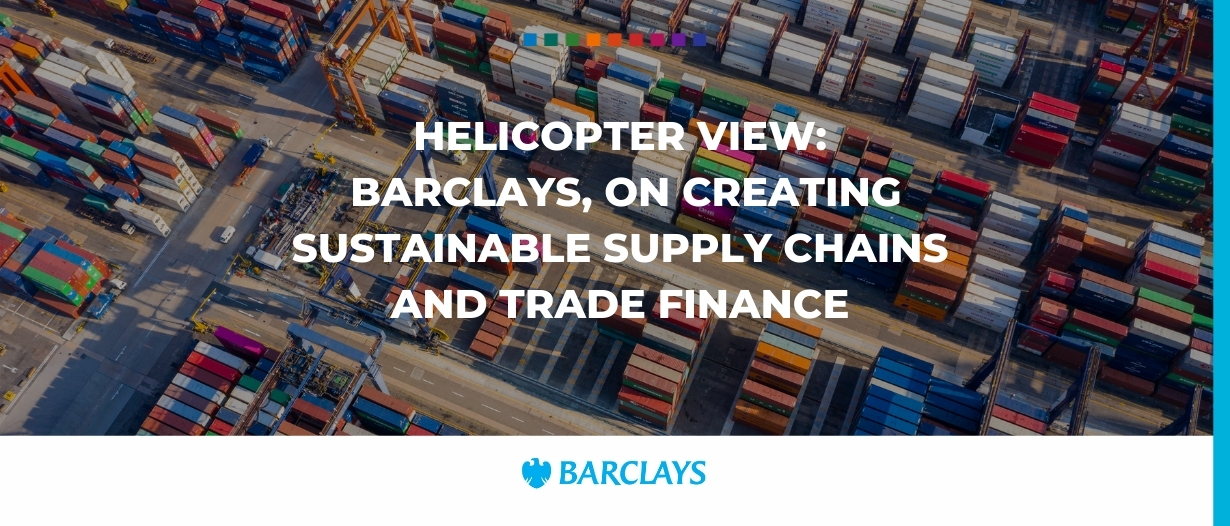How is sustainability being promoted across trade finance?
Trade finance as an asset class has benefitted from developments in loan and debt capital markets, which have led the way in sustainable product development. Well-established market standards such as the Loan Market Association’s Sustainability Linked Loan Principles and the International Capital Markets Association’s green and sustainability-linked bond principles have set a clear market standard for structuring solutions not just in the debt world but also in trade finance.
Borrowers tapping the debt markets for sustainable finance are looking at setting out overarching sustainable financing frameworks, which can be applied to any component of their capital structure. The flexibility of sustainability-linked financing is hugely favoured by borrowers across all sectors as these products do not restrict the use of the underlying funds but rather point to the sustainability trajectory that a company is following by virtue of embedding sustainability KPIs in the financing. In these constructs, borrowers are incentivised to improve their sustainability performance over time through adjustments in the pricing of their facilities depending on whether they miss or hit specific targets. We expect development and take up of sustainability-linked trade products to really take off in the next 12 months, mirroring the huge acceleration of the equivalent products in the loan market. These trade solutions are already coming to market and allowing borrowers to signal alignment of sustainability and financing strategies. Naturally, the nuances of trade products need to be factored in – however, the market is adapting quickly so far.
A clear environmental focus, the definition of green criteria and the classification of new and existing green trade finance assets have been common approaches across the major trade finance banks. We are all at different stages in the process of developing a more robust, sustainable trade product offering, but it is important that we are all aligned on where the industry should be heading: more sustainable trade finance businesses, with the ability to provide enhanced support and guidance to our clients so that they can meet their own ESG commitments.
Lessons from the increase in ESG initiatives in the banking sector
One of the key premises behind sustainable finance is that these instruments support genuine commitments and sustainability efforts. In the case of sustainability-linked solutions, the credibility of the products rests on the selection of sustainability KPIs agreed as part of the financing. It is therefore essential to select relevant and material metrics fitting the strategy and sector that the borrower operates in. Banks and investors are spending a lot of time calibrating the stretching nature of sustainability targets either through their own internal sustainability specialists or relying on independent third-parties to appraise those. Increasingly, banks state their own net zero ambitions, which require them to set targets and track the emissions of the businesses they fund or in other words financed emissions. For example, Barclays created BlueTrack™ – methodology that builds on and extends existing industry approaches towards measuring financed emissions, which has enabled us to track and report progress towards medium-term decarbonisation goals for specific high emitting sectors.
The market is most certainly maturing and raising the standard for what robust structures should look like. A good example are carbon emission targets backed by science and validated through initiatives such as the Science Based Initiative (SBTi), which defines and promotes best practice in setting emissions reductions and net-zero targets. One other aspect is the increasing importance of the reliability of sustainability data – companies are expected more and more often to externally verify their reporting, which also feeds into their financing arrangements.
As these products become better embedded and understood, and sustainability performance tracked and benchmarked, it wouldn’t be an exaggeration to say that sustainability-linked trade could become the go-to solution in the market – a trend we are seeing in the loans space where sustainability linked loans are discussed incredibly frequently compared to a couple of years ago. Sustainability KPIs can be set both across supply chains and directly on a corporate level as well, improving the direct and indirect sustainability impact of companies. Creating capacity and appetite for ESG linked trade deals will be a key driver of the finance sector’s commitments on net-zero and ESG linked assets.
Another thing we can learn from the wider financing sector (including larger multilateral agencies) is how to integrate social and governance criteria into financing offerings, in addition to environmental impact assessments. The component parts of ESG must be given ample attention, as all three principles – Environmental, Social and Governance – are interlinked, and a reduction in the impact of climate change requires consideration of all three.
For a buyer to reduce their carbon footprint they need to ensure they deal with reliable suppliers that use fair practices and sustainable methods that reduce their own environmental impact. These companies have to set clear guidelines on what is and isn’t acceptable, and that direction and supervision must come from strong leadership. This is the essence of Corporate Governance and requires an understanding of who is behind a company and the culture they promote. Buyers must also ensure they are having a positive impact on society and employ a strong CSR policy. Their relationships with both suppliers and local communities are of central importance to a holistic ESG approach.
Social bonds that incorporate all aspects of ESG – and include linked KPIs and ratings within their product offerings – are already a key part of the capital market space. The trade finance industry must also embrace this approach, to ensure it not only goes greener, but that it is more compliant with key social and governance practices.

The role of technology in creating sustainable supply chains
Technology and new automated solutions will continue to play a key role in promoting more sustainable supply chains. Data availability and reliability are two of the major obstacles the industry has faced through the years, but we are already seeing some material progress and companies are getting support from specialised agencies and platforms that provide solutions to assess better ESG compliance across the supply chain.
Buyers can incentivise suppliers to improve their performance either against predetermined KPIs, most often environmental or against ESG ratings in exchange for offering better payment options compared to less sustainable suppliers. So the financial product availability is technically present, but the challenge is capturing from a data perspective deep-tier suppliers and their performance. Technology could play a key role in that – data and software solutions are emerging to help sustainability monitoring and assessments. For example, deforestation risks and environmental impacts across commodity value chains could now be captured through data sets derived from satellites and remote sensing data sources. These are just some of the technologies that would drive transparency and ultimately promote truly sustainable practices deep into supply chains.
The multifaceted evolution of the industry
In the future, we can expect to see tightening standards around green and sustainable financing as the market matures and we get a better grasp of best practices not just for the environmental but also the social and governance aspects of ESG. So far the focus on the environmental aspect has been the strongest, however, especially post-pandemic, company strategies and as a consequence financing frameworks utilised by those companies have shown a clear focus on social – whether that is for their direct operations, across supply chains or within the communities they operate. The future of the industry won’t be purely green but will rather be a multifaceted evolution of all three components of ESG.
The role of governments in terms of regulation and supervision is also expected to play a key part in determining the future of the industry. More than 71% of the UK businesses surveyed in Barclays latest Benchmark Sustainability report think that the rules are expected to increase. But it is not only about increased regulations, but also about incentives available and how prepared our clients are for changing environmental regulations. In the coming years, collaboration between all industries (including the financial service sector) and the government is going to be critical to prepare better for the challenges ahead.
The future trade finance market will also likely feature closer collaboration between bank, corporate and third-party platforms, and more standardisation in terms of the ESG criteria applied to trade finance products. This will enable each of these key actors to better use distribution, see higher syndication volumes and utilise risk-sharing alternatives. The application of new technologies, interoperability and accessing of data gathered across the different parties will only further support this.
Co-authored by:

Philip Bowkley, Head of International Corporate Banking at Barclays Corporate
Philip Bowkley is Managing Director and Head of International Corporate Banking (ICB), he has responsibility for the Corporate Banking client franchise for International Corporate clients, Financial Institutions clients and the international Corporate Bank teams across the UK, Europe, APAC, Middle East and the Americas.
Philip joined Barclays in 2002 and prior to working in International Banking he was Head of Strategy and Transformation for Business Banking in the UK and also spent two years running a large scale transformation programme in Barclays Africa. He started his career as a Graduate at Unilever and then spent several years working as a consultant at PwC and CapGemini.

James Binns, Global Head of Trade and Working Capital at Barclays Corporate
T&WC serves Corporate, NBFI and FI clients globally with teams located in the UK, Europe, Americas, Asia and the Middle East. Prior to joining Barclays, James spent 4.5 years at Deutsche Bank where he headed Working Capital Advisory and Trade Finance for EMEA and latterly Global Cross Product Solutions.





























